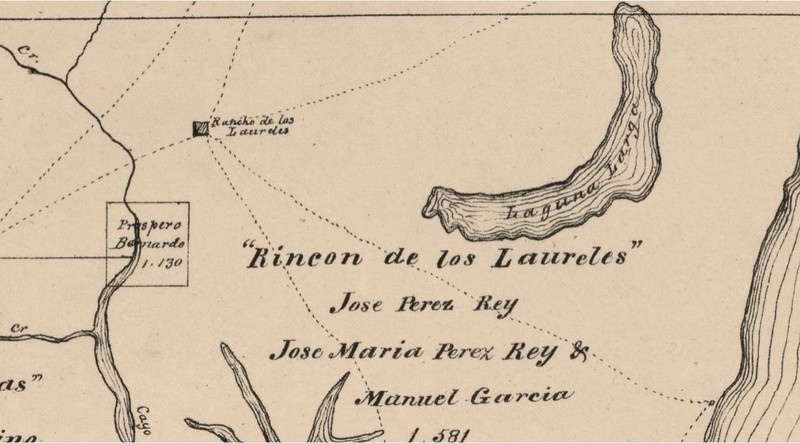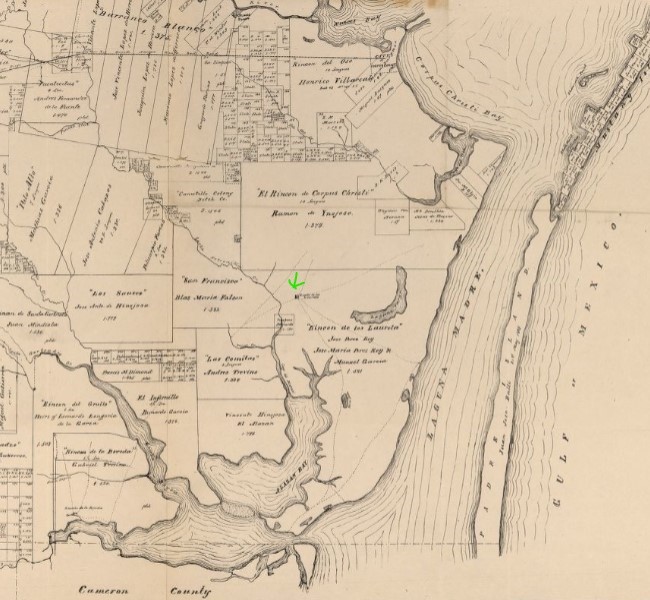Laureles Ranch House Museum
Introduction
Text-to-speech Audio
Images
Closeup of headquarters at "Rancho de los Laureles" on 1879 map (Walsh)

Laureles Ranch headquarters (green arrow) on 1879 map of Nueces County, TX (Walsh 1879)

Backstory and Context
Text-to-speech Audio
Charles Stillman was the son of a New England merchant, Francis Stillman. Charles moved to Matamoros, Mexico in 1828 at age sixteen and operated a store for his father's company in Durango, Mexico. Charles became a highly successful businessman and was involved in multiple enterprises including a river boat company, a cotton brokerage, and silver mines and textile mills in Mexico. He married Elizabeth P. Goodrich of Connecticut in 1849. In the late 1840s he founded the Brownsville Town Company with partners Samuel Belden and Jacob Mussina. He built a substantial home in Brownsville in 1950 (also a Clio entry). During the Civil War, his company transported Confederate cotton to Matamoros, Mexico, and was paid for the transport in gold. Stillman purchased much of the cotton and sent it to his textile mill in Monterrey or sold it to New York buyers or the U.S. Government through his mercantile firm, Smith and Dunning.
Charles Stillman raised cattle, sheep, and horses on his Texas ranch north of Brownsville. The Rey family gave the land grant the name "Rincon de Los Laureles," meaning "Corner of the Laurels." After suffering two strokes, Charles decided to give up ranching and life in Texas; he sold the property to his brother, Cornelius, in 1864. Charles and his wife, Elizabeth, moved to New York; Charles died there in 1875.
The new owner of the ranch in 1868 was Mifflin Kenedy; the 50-year-old was one of Charles Stillman's business partners. Kenedy became known for being one of the first Texas ranchers to fence off his land. He enclosed three sides of Los Laureles in 1869 with smooth wire fence (the fourth side was the coastal waters). A Scottish syndicate, the Texas Land and Cattle Company, bought the Laureles Ranch in 1882, paying Kenedy more than a million dollars. A Scotsman named John Tod became the ranch manager. Tod greatly improved the cattle stock on the ranch and won many livestock awards. The 200,000-acre ranch and all of its cattle was purchased from the syndicate in 1906 by Henrietta King, the widow of the rancher Richard King. The Laureles became part of the massive King Ranch; it was west of King's Santa Gertrudis Ranch. The sale made Mrs. King the owner of one of the largest ranch in the world, of a million and a quarter acres in four counties: Nueces, Cameron, Hidalgo and Starr. Laureles Ranch has remained one of the divisions of the King Ranch for over one hundred years.
The building materials for the ranch house may have been prefabricated and sent to Texas; numerals have been seen carved into some of the wooden elements. The restored ranch home's wraparound porches and grounds are highlights of the visitor experience. The Laureles Ranch House Museum is part of the Mitte Cultural District and is within walking distance of many local zoos, parks, and museums. The Visitor Center for the district is located off the Sixth Street exit of Highway 69. The Roy F. and Joann Cole Mitte Foundation funded restoration of Dean Porter Park in 1998 which now offers walking trails, picnic shelters and a swimming pool on twenty-five acres. The foundation recognized that the area surrounding the park was the locale of many of the town's cultural organizations. Other nearby attractions in the Mitte Cultural District are the Gladys Porter Zoo, the Camille Playhouse theater, the Children's Museum of Brownsville, the Old City Cemetery (another Clio entry), and the Brownsville Museum of Fine Art.
Sources
Anonymous. "Closing the Sale." Brownsville Daily Herald (Brownsville, TX) July 26th 1906. 1-1.
Anonymous. "Texas Notes." Brownsville Daily Herald (Brownsville, TX) September 21st 1906. 2-2.
Ashton, John. Kenedy, Mifflin (1818 - 1895), TSHA Handbook of Texas. Accessed September 25th 2020. https://www.tshaonline.org/handbook/entries/kenedy-mifflin.
Ashton, John. Laureles Ranch, TSHA Handbook of Texas. Accessed September 25th 2020. https://www.tshaonline.org/handbook/entries/kenedy-mifflin.
Brownsville Historical Association. The History of Los Laureles Ranch House, Laureles Ranch House Museum. January 1st 2019. Accessed September 19th 2020. https://www.brownsvillehistory.org/historic-laureles-ranch-house.html.
Hart, John Mason. Stillman, Charles (1810-1875), Texas State Historical Association Handbook of Texas. Accessed September 21st 2020. https://www.tshaonline.org/handbook/entries/stillman-charles.
Mitte Cultural District. Experience the Mitte Cultural District, Roy F. and Joann Cole Mitte Cultural District. January 1st 2019. Accessed September 19th 2020. https://mitteculturaldistrict.org/.
Mitte Cultural District. Laureles Ranch House Museum, Roy F. and Joann Cole Mitte Cultural District. January 1st 2019. Accessed September 19th 2020. https://mitteculturaldistrict.org/laureles-ranch-house-museum/.
https://www.loc.gov/item/2012590093/
https://www.loc.gov/item/2012590093/
